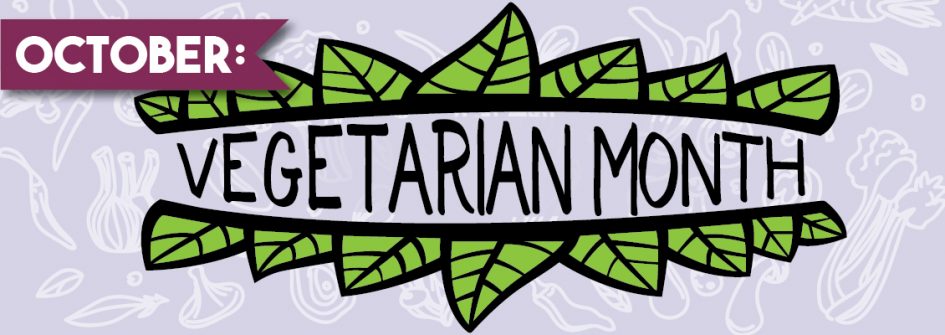October kicks off Vegetarian Awareness Month which focuses on eating a plant-based diet. There are different variations of vegetarians but each level of vegetarianism removes meat from their diet. The levels of vegetarianism are as follows:
- Flexitarian/Semi-Vegetarian
- Individuals who eat a mostly vegetarian diet but will occasionally eat meat
- Pescatarian
- Individuals who eliminate all meat except fish. Some individuals prefer this version of vegetarianism because they can still enjoy the health benefits associated with eating fish.
- Lacto-Ovo-Vegetarian
- These individuals do not eat meat such as fish,
poultry, pork, beef, shellfish, or animal flesh of any kind but will still
consume eggs and dairy products. These are the most vegetarians.
- Fun Fact: “Lacto” is Latin for milk and “Ovo” means egg.
- Individuals can choose to be one or the other by being a lacto-vegetarian or ovo-vegetarian. Meaning they will consume only dairy products (no egg) or only eggs (no diary).
- These individuals do not eat meat such as fish,
poultry, pork, beef, shellfish, or animal flesh of any kind but will still
consume eggs and dairy products. These are the most vegetarians.
Eating a plant-based diet is nothing new and is the type of diet that our ancestors grew up on. There are many health benefits associated with a plant-based diet because of all the wonderful vitamins and minerals that are in plant-based foods. You may ask yourself, how will I get enough protein? Although it is a bit more challenging to meet your protein needs with a vegetarian diet, it is not impossible. Vegetarians obtain their protein from nuts, seeds, tofu, lentils, and beans but can also obtain protein from eggs and dairy products if they choose.
Why choose vegetarianism? Being vegetarian is a personal preference and is more than just eliminating meat from the diet. A vegetarian diet helps ensure your body gets the vitamins and minerals it needs to function properly by increasing the amount of whole foods in your diet. It also helps save the lives of innocent animals because the demand for meat decreases with more individuals choosing this lifestyle.
When dining with us in our dining halls you can refer to our signs at each serving station that display which entrées are vegan and which are vegetarian. This differentiation is noted by symbols and a legend that describe what each symbol means.
Esker has a ‘Be Well’ station where you can build your own stir fry using an array of vegetables and plant-based proteins. This station is a great way to customize your meal and be in charge of what you eat. Drumlin has a Mongolian Grill where you can customize your dinner and again be in charge of what you are eating.
Both locations have a salad/deli bar area and various compost salads which have plant-based options available. Other options on campus include our Good to Go program that is available at our retail locations. This program includes fruit/vegetable & yogurt parfaits, boiled eggs, vegan salads & wraps, vegan snack packs, PB&J, and our new overnight oats cups.
Not sure if a vegetarian diet is right for you? Try to start with Meatless Monday’s and test out your cooking skills by making a meal that is based around plant proteins such as black beans or chickpeas. We challenge you to try to reduce your animal consumption for the month of October.
Try this BBQ Bean Taco with Pineapple Salsa recipe: Who said being vegetarian has to be bland?
BBQ BEAN TACOS WITH PINEAPPLE SALSA
If you want to learn more about your vegan and vegetarian options on campus or if you want to know if it is the right diet plan for you, reach out to our campus Dietitian Rachael Omdoll by filling out this online form: uww.edu/uc/hawkcard/dining-services/ask-the-dietitian
Written By: Rachael Omdoll, Campus Dietitian
Make sure to stay up-to-date with out specials and events: uww.edu/uc/hawkcard/dining-services

Leave a Reply